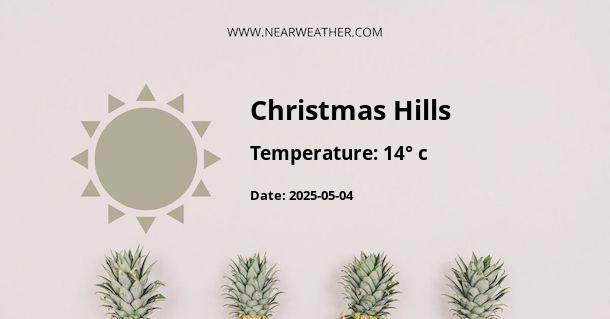Climate and Weather in Christmas Hills, Australia
Christmas Hills, located in the state of Victoria, Australia, experiences a temperate climate with distinct seasons throughout the year. The region is known for its picturesque landscapes, lush greenery, and pleasant weather. Let's take a closer look at the climate and weather patterns in Christmas Hills year-round.
Temperature
The temperature in Christmas Hills varies significantly between seasons. Summers are warm, while winters can be quite chilly. Here is a breakdown of the average monthly temperatures:
| Month | Temperature (°C) |
|---|---|
| January | 25 |
| February | 25 |
| March | 22 |
| April | 18 |
| May | 14 |
| June | 11 |
| July | 11 |
| August | 12 |
| September | 14 |
| October | 17 |
| November | 20 |
| December | 23 |
As we can see, January and February are the warmest months, with average temperatures of 25°C. Winter months, including June and July, are the coolest, with average temperatures dropping to around 11°C. It is important to note that these temperatures are averages, and the actual temperatures can vary from year to year.
Precipitation
Christmas Hills receives a moderate amount of rainfall throughout the year. The region experiences a typical Mediterranean climate, with wetter winters and drier summers. Here is an overview of the average monthly precipitation:
| Month | Precipitation (mm) |
|---|---|
| January | 47 |
| February | 42 |
| March | 45 |
| April | 52 |
| May | 57 |
| June | 56 |
| July | 55 |
| August | 58 |
| September | 59 |
| October | 58 |
| November | 55 |
| December | 51 |
As shown in the table, the wettest months are May, September, and October, with average precipitation ranging from 57mm to 59mm. Conversely, the driest months are January and February, with average precipitation of 47mm and 42mm, respectively. These rainfall patterns contribute to the region's lush vegetation and beautiful landscapes.
Sunshine Hours
Christmas Hills enjoys a good amount of sunshine throughout the year, with an average of 7-8 hours of sunshine per day. The region experiences longer daylight hours during the summer months and shorter daylight hours during winter. This ample sunshine allows for various outdoor activities and makes the region a great place to explore.
Wind
The wind patterns in Christmas Hills are influenced by the surrounding topography and weather systems. The region experiences prevailing winds from the northwest, which can bring cooler air from the nearby mountains. However, the strength and direction of the wind can vary depending on the weather systems passing through the area.
Climate Adaptation
Given the climate and weather patterns in Christmas Hills, it is essential for residents and visitors to adapt to the conditions. Here are some climate adaptation strategies:
- During the warmer months, it is important to stay hydrated and protect yourself from the sun by wearing sunscreen and appropriate clothing.
- In winter, ensure you have adequate insulation and heating to stay comfortable indoors.
- Be prepared for rain by carrying an umbrella or wearing waterproof clothing, especially during the wetter months.
- Stay informed about weather forecasts and any potential weather-related hazards.
Conclusion
Christmas Hills, Australia, offers a temperate climate with distinct seasons. The region experiences warm summers, cool winters, and moderate rainfall throughout the year. With its beautiful landscapes and pleasant weather, Christmas Hills is an ideal destination for outdoor enthusiasts and nature lovers.
A - Christmas Hills's Latitude is -37.650002 & Longitude is 145.333328.
A - Weather in Christmas Hills is 23° today.
A - Climate Conditions in Christmas Hills shows overcast clouds today.
A - Humidity in Christmas Hills is 48% today.
A - Wind speed in Christmas Hills is 5.33 km/h, flowing at 26° wind direction. today.
